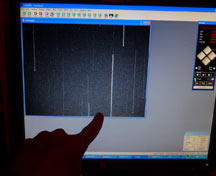
At 4:16am on Saturday morning, a 10.0 mag star was predicted to be occulted by the dim asteroid Shaposhnikov along a path centered along the length of the Central Valley, into the LA area. Weather was predicted to be clear and good, as an extreme high pressure cell was making for record heat this weekend. The rank was mediocre at best. If it had been better, I'd have been more tempted to drive up to Chris Kitting's and finally recover the camera and video gear I'd left behind after our previous occultation expedition... but, the odds of an occultation on the centerline was still less than 38%, not sufficient for me to sacrifice the entire night and a tank of gas chasing it. Instead, I'd hope for a south shift and try it from Cabrillo College Observatory. The plan was to spend the night at the observatory, working on diagnosing the poor pointing performance lately of the the 12" scope, then getting up at 3:20am to prepare for the occultation. Hopefully then sleep for a couple more hours, and then do a bike training ride into the local mountains.
The weather stayed good all night. But, building the new Gemini mount model was frustrating. The pointing accuracy upon median flip was terrible; off by 5-10 degrees in right ascension (and pretty good in Declination). If I'd not been so tired from an earlier swim workout and having a virus I was fighting off, I'd have realized sooner the symptoms pointed to mirror flop due to an inadequate spring on the retaining bolt. But instead, I just kept pointing to new stars, refining the model, and not making any progress, until I gave up at 12:30am.
Got up with the alarm at 3:30am, pulled out the 10" and got it set on the target star quite fast - the double star near the target made locating the target very easy, for a change. I tried to get a star trail image of the occultation on the 12". Getting it set on the target wasn't too hard. Getting the event this way was unlikely, however, since the duration of the event was about 18 seconds and the uncertainties meant I'd have to start the exposure, run out to the 10" and get it properly visually, and hope the event was early enough to record before the star ran off the field-of-view or the exposure ended. As it turned out the 21% odds of an occultation were not good enough, and I had a miss.
We had a good observing fence set up, and the asteroid would have to thread the needle to avoid all of us... which apparently is exactly what it did. Everyone got a miss! Ted, Bob Jones, me... I'll post the profile page when it's ready to do so. Here's my .xls report
|
The bright star at right is the 10.0 magnitude target star. Nice to know that stars that bright make great star trails for future reference. No break in the path, because no occultation happened here. |
